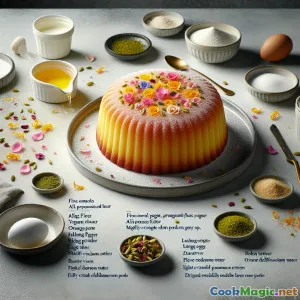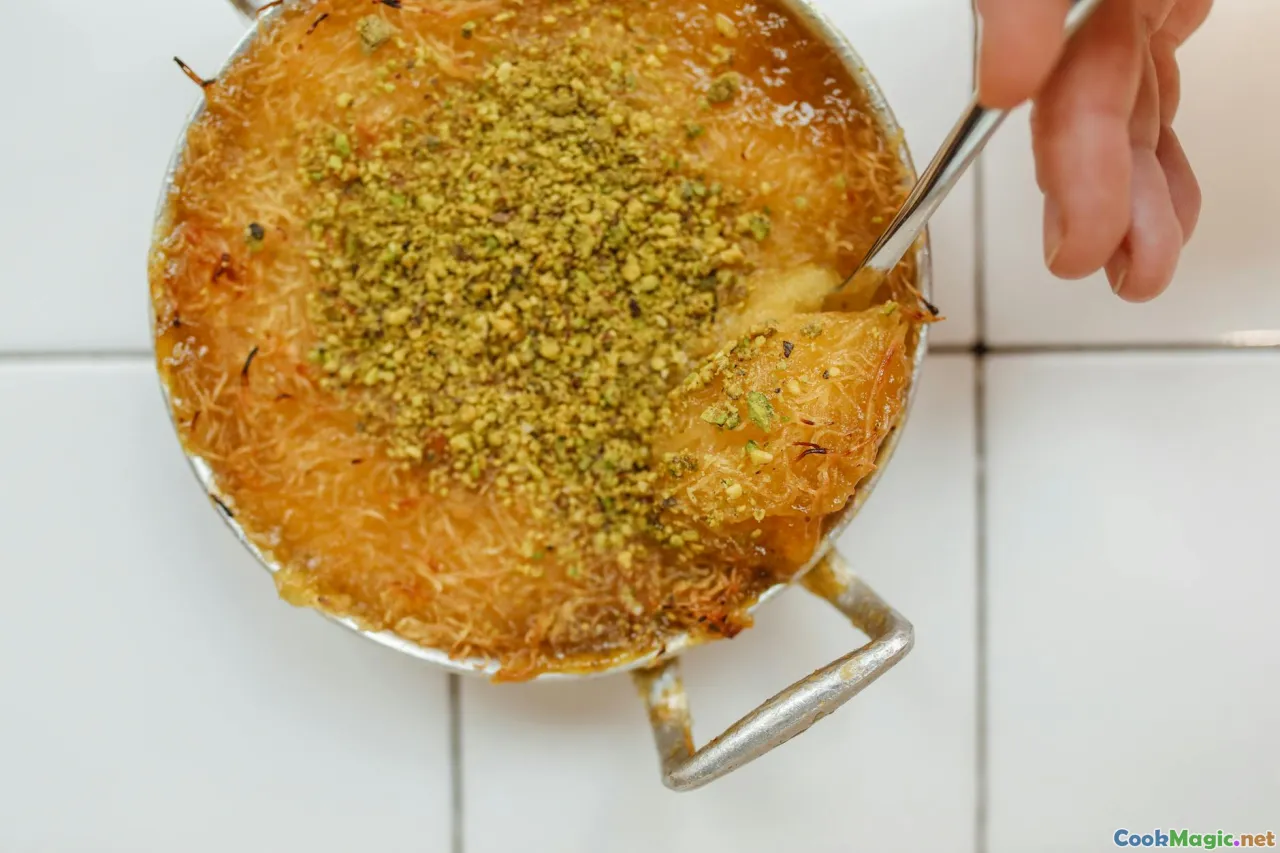
Torta Tulumba di semola all'acqua di rose
(Tulumba Rosewater Semolina Cake)
(0 Recensioni)0
386
ottobre 04, 2025
Segnala un problema
Ingredienti
-
300 grams Semolino fine
(Use fine or extra-fine for a tender crumb)
-
60 grams Farina 00
(Helps bind and lighten texture)
-
150 grams Zucchero granulare (impasto)
(For the cake, not the syrup)
-
240 grams Yogurt intero naturale
(Room temperature for best mixing)
-
3 large uova grandi
(Temperatura ambiente)
-
100 grams Burro non salato, fuso
(Or substitute 90 ml neutral oil)
-
10 grams Lievito in polvere
(Approximately 2 teaspoons)
-
0.5 tsp sale marino fine
(Equilibra la dolcezza)
-
1 tsp Estrazione di vaniglia pura
(Adds warmth to aroma)
-
1 tsp Zeste di limone finemente grattugiato
(Grattugiato fresco per maggiore brillantezza)
-
400 grams Zucchero semolato (sciroppo)
(For the soaking syrup)
-
360 ml Acqua
(For the syrup)
-
1 tbsp Succo di Limone Fresco
(Prevents crystallization)
-
2 tbsp Acqua di rose
(Food-grade; adjust to taste)
-
1 tsp acqua di fiori d'arancio
(Floral complexity)
-
2 pods bacche di cardamomo verde, leggermente schiacciate
(Fragrant spice note)
-
1 piece striscia di scorza di limone
(Adds citrus oils to syrup)
-
30 grams Pistacchi tritati
(Per guarnire)
-
1 tbsp Petali di rosa commestibili essiccati
(Per guarnizione e aroma)
(Use fine or extra-fine for a tender crumb)
(Helps bind and lighten texture)
(For the cake, not the syrup)
(Room temperature for best mixing)
(Temperatura ambiente)
(Or substitute 90 ml neutral oil)
(Approximately 2 teaspoons)
(Equilibra la dolcezza)
(Adds warmth to aroma)
(Grattugiato fresco per maggiore brillantezza)
(For the soaking syrup)
(For the syrup)
(Prevents crystallization)
(Food-grade; adjust to taste)
(Floral complexity)
(Fragrant spice note)
(Adds citrus oils to syrup)
(Per guarnire)
(Per guarnizione e aroma)
Nutrizione
- Porzioni: 12
- Dimensione Porzione: 1 square (80g)
- Calories: 430 kcal
- Carbohydrates: 0 g
- Protein: 6 g
- Fat: 14 g
- Fiber: 2 g
- Sugar: 40 g
- Sodium: 160 mg
- Cholesterol: 45 mg
- Calcium: 90 mg
- Iron: 1.8 mg
Istruzioni
-
1 - Make the syrup:
Combine sugar (syrup), water, lemon peel, and cardamom in a saucepan. Bring to a gentle boil, then simmer 8–10 minutes until slightly thickened. Remove from heat, stir in lemon juice, rosewater, and orange blossom water. Cool completely; chill to speed cooling.
-
2 - Prep oven and pan:
Heat oven to 175°C (350°F). Grease a 23×33 cm (9×13 in) pan and line with parchment for easy release.
-
3 - Combine Dry Ingredients:
Whisk semolina, flour, baking powder, and salt in a bowl until evenly distributed.
-
4 - Whisk wet base:
In a separate bowl, whisk eggs and sugar (batter) until slightly pale. Add yogurt, melted butter, vanilla, and lemon zest; whisk until smooth.
-
5 - Hydrate the semolina:
Fold dry ingredients into wet until just combined. Rest 10 minutes so semolina hydrates and thickens for an even crumb.
-
6 - Pan and score:
Spread batter into pan; smooth top. Optionally score shallow lines for squares or diamonds to guide cutting after baking.
-
7 - Bake to Golden:
Bake 30–35 minutes until deep golden and the center springs back (internal ~95°C/203°F). Rotate pan once for even color if needed.
-
8 - Hot cake, cold syrup:
Remove cake; immediately cut along score lines. Slowly ladle the cold syrup over the hot cake, allowing it to absorb before adding more.
-
9 - Rest and absorb:
Let the cake sit 20–40 minutes to drink up the syrup. For a juicier texture, cover and rest longer at room temperature.
-
10 - Garnish and Serve:
Scatter pistachios and rose petals. Serve at room temperature with tea or coffee. Store covered for up to 4 days.
Combine sugar (syrup), water, lemon peel, and cardamom in a saucepan. Bring to a gentle boil, then simmer 8–10 minutes until slightly thickened. Remove from heat, stir in lemon juice, rosewater, and orange blossom water. Cool completely; chill to speed cooling.
Heat oven to 175°C (350°F). Grease a 23×33 cm (9×13 in) pan and line with parchment for easy release.
Whisk semolina, flour, baking powder, and salt in a bowl until evenly distributed.
In a separate bowl, whisk eggs and sugar (batter) until slightly pale. Add yogurt, melted butter, vanilla, and lemon zest; whisk until smooth.
Fold dry ingredients into wet until just combined. Rest 10 minutes so semolina hydrates and thickens for an even crumb.
Spread batter into pan; smooth top. Optionally score shallow lines for squares or diamonds to guide cutting after baking.
Bake 30–35 minutes until deep golden and the center springs back (internal ~95°C/203°F). Rotate pan once for even color if needed.
Remove cake; immediately cut along score lines. Slowly ladle the cold syrup over the hot cake, allowing it to absorb before adding more.
Let the cake sit 20–40 minutes to drink up the syrup. For a juicier texture, cover and rest longer at room temperature.
Scatter pistachios and rose petals. Serve at room temperature with tea or coffee. Store covered for up to 4 days.
Ulteriori informazioni su: Torta Tulumba di semola all'acqua di rose
Overview
Tulumba Rosewater Semolina Cake marries the syrup-soaked allure of classic Turkish tulumba with the plush crumb of a baked semolina tray cake. Instead of frying choux as you would for tulumba, this recipe channels the dessert’s signature floral-citrus syrup into a tender, oven-baked cake—less fuss, less oil, and every bit as celebratory. The result is a golden, aromatic slice with defined semolina texture, a gentle yogurt tang, and a perfume of rose and citrus that lingers in the room.
What Makes It Special
- Hot–cold principle: Pouring chilled syrup over a just-baked, hot cake ensures rapid absorption without sogginess. This contrast locks in moisture and creates the glossy, jewel-like finish associated with syrup pastries across the region.
- Balanced florals: Rosewater is complemented by a whisper of orange blossom and citrus zest. Even those wary of floral notes usually appreciate this restrained, layered approach.
- Semolina science: Semolina’s coarse starch granules absorb syrup differently than wheat flour, yielding a slice that’s satisfyingly moist yet pleasantly nubby. Resting the batter briefly before baking lets semolina hydrate, giving a more even crumb and fewer tunnels.
Cultural Thread
Tulumba, beloved from Türkiye to the Balkans, is part of a family of syrup desserts that also includes revani (a semolina cake), şambali, and Middle Eastern basbousa/harissa. These sweets share a common logic: simple pantry staples transformed by syrup into something luxurious, meant for sharing at tea time, festive tables, and holidays such as Ramadan and Eid. This cake tips its hat to tulumba’s defining syrup—lemony, bright, and sometimes floral—while adopting the tray-bake convenience of revani. It’s a practical, modern bridge between traditions, perfect for gatherings when you crave the tulumba profile without deep-frying.
Texture and Flavor Notes
Expect a burnished top that drinks syrup without collapsing, thanks to a small proportion of flour for structure. Yogurt lends tenderness and subtle tang; butter adds richness. The syrup is intentionally light-to-medium in body so it permeates the crumb rather than pooling. Cardamom pods are optional; two pods bring a delicate, warm breath that plays well with rosewater and citrus without competing.
Tips for Success
- Choose fine semolina: Extra-fine or fine grades produce a cohesive crumb; coarse semolina can lead to crumbliness unless rested longer.
- Rest the batter: The 10-minute rest allows semolina to hydrate so the cake bakes evenly with a refined bite.
- Control the syrup: Simmer to a gentle thread stage (about 8–10 minutes). Over-reducing creates a heavy syrup that sits on top rather than soaking in.
- Hot meets cold: For maximal absorption, the cake should be hot and the syrup cold. If both are warm, absorption slows and the texture can turn mushy.
- Don’t oversoak: Add syrup gradually. When it stops absorbing quickly, pause 2–3 minutes and add another ladle. You want moist, not sodden.
- Garnish thoughtfully: Pistachios add color and crunch; edible rose petals reinforce the aroma beautifully but use a light hand.
Make-Ahead and Storage
The cake actually improves after several hours as the syrup equilibrates. Bake the day before serving and keep covered at room temperature. It will keep for up to four days. If your environment is humid, place a sheet of parchment between cake and lid to prevent condensation.
Variations
- Citrus swap: Replace rosewater with extra lemon zest and a touch more lemon juice for a purely citrusy finish.
- Almond lift: Add 50 g of finely ground almonds to the batter and reduce semolina by the same amount for a softer crumb.
- Spice route: Infuse the syrup with a small cinnamon stick in place of cardamom, removing it before adding rosewater.
- Orange blossom forward: Skip rosewater and use 2 teaspoons of orange blossom water for a different floral profile.
- Dairy-free: Substitute yogurt with a thick plant yogurt and butter with neutral oil; texture remains moist and tender.
Serving Ideas
Serve at room temperature with Turkish black tea, mint tea, or strong coffee. For a plated dessert, add a dollop of lightly sweetened labneh or whipped cream and a few segments of fresh orange to echo the citrus in the syrup.
Why This Works
The interplay of semolina’s absorptive power, the structural support of a small flour portion, and the hot–cold syrup technique underpins the cake’s success. The lemon juice in the syrup controls crystallization while rosewater and optional orange blossom water provide distinct but restrained aromatics. Together they create a cake that tastes like tulumba distilled into a slice: fragrant, bright, and irresistibly moist—without the fryer.





















